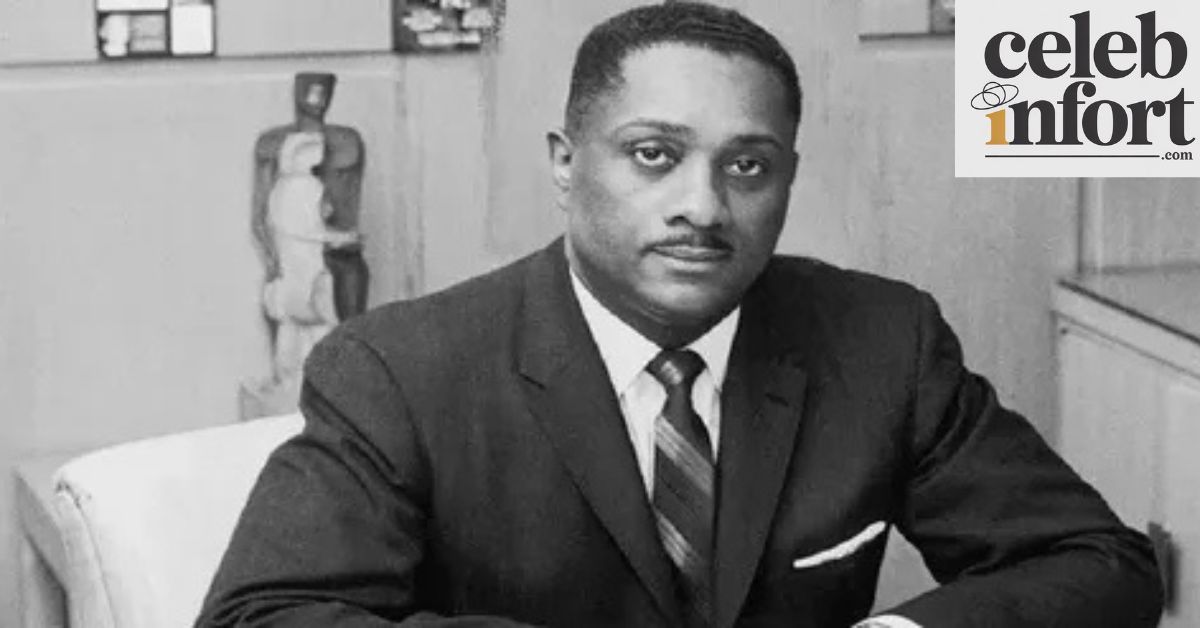John H. Johnson net worth continues to inspire generations in 2025, standing as a testament to determination, creativity, and visionary leadership. Born into poverty in Arkansas City, Arkansas, John Harold Johnson transformed his life through sheer resilience and became one of America’s most respected African-American entrepreneurs.
As the Johnson Publishing Company, he built an empire that shaped Black media and culture for decades. His iconic creations—Ebony magazine and Jet magazine—not only entertained but also empowered the African-American community by celebrating Black excellence and success. Today, his financial legacy and cultural influence remain unmatched, reminding the world how persistence and purpose can redefine history.
Early Life and Education of John H. Johnson
Born on January 19, 1918, in Arkansas City, Arkansas, John H. Johnson grew up in the shadow of poverty and segregation. His father died in a sawmill accident when John was six, and his mother labored as a cook in a levee camp during the 1927 Mississippi Flood 1927. The family’s move to Chicago, Illinois, in 1933 amid the Great Migration stirred his ambition. At DuSable High School, John stood out as student council president and editor of the school paper. He was later offered a scholarship to the University of Chicag,o but turned it down because he lacked funds for other costs. His early exposure to racial and economic barriers laid the groundwork for his future rise as an African-American entrepreneur.
By working part-time at the Supreme Life Insurance Company, he learned how news clippings, mailing lists, and insurance policyholder databases could form a publishing enterprise. That experience eventually inspired him to eventually found the Johnson Publishing Company. His early life set the stage for a financial success story, as he refused to accept limits imposed by society.
YOU CAN ALSO READ THIS: Net Worth of Goodwill CEO Steven C. Preston
How John H. Johnson Started His Career
John’s career began modestly at Supreme Life in Chicago. His job: scan newspapers, compile digests, learn what African-American readers wanted. By 1939, he had dropped out of college to work full-time. During this period, he conceived of a magazine for Black readers patterned after the digest format of Reader’s Digest. In 1942, he borrowed $500, using his mother’s furniture as collateral, to launch his first magazine, Negro Digest. That bold move marked the beginning of his publishing empire.
Through innovative guerrilla-marketing tactics — mailing offers to thousands of policyholders, personally recruiting news-stand sales, paying friends to buy up copies — John turned a small loan into tens of thousands of subscriptions. Soo,n his work at Supreme Life and his political connections (including with Earl Dickerson) gave him insight into the Black media marketplace. These efforts launched the foundation for his later success with the magazines that would define his company and boost his net worth growth.
The Birth of Johnson Publishing Company
In 1942, John incorporated the Johnson Publishing Company, using lessons learned at Supreme Life to build a publishing business aimed at Black readers. The first major title, Negro Digest, struck a chord by featuring Black professionals, artists, and historians — countering mainstream stereotypes. Its early success proved that the Black consumer market was untapped.
By 1945, he launched the magazine Ebony, modeled after Life magazine in size and style but devoted to African-American life and achievement. This move firmly established the Johnson Publishing Company founder as a media pioneer. The company expanded further with titles like Jet in 1951, cementing the firm’s role in African-American media leadership. The business empire that emerged became the largest Black-owned publishing firm in the U.S. and a major component of John H. Johnson’s wealth.
Success of Ebony and Jet Magazines
Ebony and Jet magazines reshaped how Black America saw itself and how advertisers saw Black consumers. Ebony set out to showcase successful African-Americans, star models, and high-quality photography. Jet, a weekly news-digest, covered the Civil Rights Movement with depth, including the coverage of the Emmett Till case. Within a few years, Ebony sold out its first print run of 25,000 copies; Jet quickly reached hundreds of thousands of weekly readers.
This success translated into advertising revenue and enabled John H. Johnson to demonstrate the purchasing power of Black consumers to major corporations. He used this to leverage deals, launch other ventures (such as Fashion Fair Cosmetics) and expand his empire. The popularity of these magazines was central to the growth of his publishing empire and was a key driver of his eventual John H. Johnson net worth.
John H. Johnson Net Worth Over the Years
Tracking the financial trajectory of John H. Johnson shows how he leveraged media, advertising, and consumer insight to accumulate wealth. In 1982, he became the first African-American to appear on the Forbes 400 1982 list. Reports from the 1980s placed his wealth in excess of $100 million. A 1990 obituary estimated his personal wealth at about $150 million.
Here is a simplified table of key milestones:
| Year | Estimated Net Worth | Highlight |
| 1950 | ~$500,000 | Launch of Ebony magazine |
| 1970 | ~$20 million | Jet circulation grows |
| 1982 | First African-American on Forbes 400 | Breakthrough listing |
| 1990 | ~$150 million | Established media empire |
While precise figures for 2025 are unavailable, his company’s success and diversified ventures ensure his legacy remains a benchmark in black wealth in America.
Sources of Income and Major Investments
John H. Johnson’s income streams were diversified far beyond just magazine subscriptions. His core business — the Johnson Publishing Company — generated income through advertising, subscriptions, and news-stand sales. He expanded into real estate, cosmetics (Fashion Fair Cosmetics), book-publishing (e.g., Before the Mayflower), radio ownership, and even television production.
For example, the Ebony Fashion Fair, launched in 1958, toured over 200 cities and raised millions for charity via the United Negro College Fund. The firm also acquired property in downtown Chicago, entered broadcasting-station ownership (WJPC-AM), and held shares in other publications such as Essence magazine. These investments helped stabilize his wealth during periods when magazine circulation dipped and reinforced his reputation as a millionaire businessman.
Awards, Honors, and Recognitions
John H. Johnson earned numerous awards, recognizing both his business success and cultural impact. In 1996, he received the Presidential Medal of Freedom 1996, the United States’ highest civilian honor. He was named by Black Enterprise the “Entrepreneur of the Decade” in 1987. Additional accolades include the Spingarn Medal, the Horatio Alger Award, the Golden Plate Award, and induction into the Chicago Business Hall of Fame.
His awards highlight his dual achievements: he succeeded as a business leader and also transformed representation in media. As he once said, “When I see a barrier, I cry and I curse, and then I get a ladder and climb over it.”
Personal Life and Family Background
John H. Johnson married Eunice Walker Johnson in 1941, and together they built not just a media dynasty but a family institution. They adopted two children: John Harold Johnson Jr. and Linda Johnson Rice, who later became the CEO of Johnson Publishing Company. The family’s presence in Chicago and beyond reflected the success of their business and commitment to philanthropic causes.
Their home address in Chicago, the company headquarters at 820 South Michigan Avenue, and John’s final resting place at Oak Woods Cemetery are physical markers of a life rooted in place, legacy, and community. Their story also illustrates American themes of education, opportunity, entrepreneurship, and cultural identity.
Challenges and Personal Tragedies
Despite his tremendous success, John H. Johnson faced deep personal and professional setbacks. His son died at age 25 from sickle-cell anemia, a profound loss for the family. On the professional side, shifts in print media and advertising forced the company to adjust its strategies. During the 1950s, Ebony’s circulation once dropped by 100,000 in a month, forcing John to reinvent his business model.
Racial barriers also loomed large: banks refused loans, news-stand distributors balked at Black-owned magazines, and real-estate deals in downtown Chicago were blocked. Yet he persevered — fighting structural racism while growing a publishing empire. His ability to navigate such turmoil remains part of his enduring legacy of entrepreneurship under pressure.
Death, Funeral, and Lasting Legacy
John H. Johnson died on August 8, 2005, in Chicago. His funeral at the Rockefeller Memorial Chapel attracted thousands, including future U.S. President Barack Obama and former President Bill Clinton. He was buried at Oak Woods Cemetery. Today, his legacy lives on via the John H. Johnson Museum and Educational Center in Arkansas City and the recognition of November 1 as John H. Johnson Day.
His media archive (nearly 3 million negatives and 1 million photos) was transferred to the Smithsonian and Getty in 2022, underscoring his impact on African-American media, representation, and history. John H. Johnson’s life remains a monumental chapter in Black history publishing and American entrepreneurship.
Frequently Asked Questions
What was John H. Johnson’s net worth at the time of his death?
Estimates place his net worth around $150 million by the early 1990s, though precise figures at his death in 2005 vary. His company’s success and diverse investments suggest substantial wealth, even if later industry shifts reduced its value.
How did John H. Johnson become so successful?
He recognized the spending power of Black consumers, launched magazines like Ebony and Jet, leveraged advertising from major corporations, and diversified into cosmetics, real estate, and broadcasting. In doing so, he built an empire where none existed.
What companies did John H. Johnson own?
He founded the Johnson Publishing Company, published Ebony and Jet, launched Fashion Fair Cosmetics, acquired radio stations, and invested in book-publishing and media ventures. His companies embodied Black-owned business success.
Who runs Johnson Publishing Company now?
In 2002, John appointed his daughter, Linda Johnson Rice, as CEO. The family maintained leadership until the company sold its major titles in later years, reflecting changes in the publishing industry.
What is John H. Johnson remembered for today?
He is remembered as a trailblazing “millionaire businessman” who broke racial barriers, created media platforms for African-Americans, and demonstrated what Black entrepreneurship could achieve in America.
Conclusion:
John H. Johnson’s journey from the levees of Arkansas to Chicago’s publishing elite is a story of vision, resilience, and transformation. He founded Ebony and Jet, built the Johnson Publishing Company, and pioneered representation in media. His status as the first African-American on the Forbes 400 list marked a turning point in black wealth in America.
His example teaches us that entrepreneurship is not just about profit, but about giving voice, building community, and rewriting narratives. As you reflect on his legacy, remember that the ladders he climbed were not simply for him — they helped elevate a whole generation.

